- Top Trumpet Embouchure Techniques: Options for Beginners Through Professionals - October 12, 2022
- Is the Trumpet Hard to Learn? - September 30, 2022
- Best Leblanc Clarinet Models Guide: From Soprano to Contrabass - September 5, 2022
Did you know that a horn has about 12 feet of tubing? That’s right, don’t let the shape fool you. Having that amount of tubing can make it hard to learn how to play the horn, but it isn’t impossible.
Whether you’ve played other instruments or not, the horn is a great option. It’s not super common, so you won’t have a problem getting solo gigs or finding a group to play with. Do you want to play the horn? Read on to learn how to get started.
What Is The Horn?
The horn (or French horn) is a type of brass instrument, and you can hear it in orchestras, bands, and chamber music. Early versions of the horn were very simple since they didn’t have any valves. Hunters would use them to attract animals, so the coil design allowed people to hang the horn on their shoulders. Over time, the horn developed, and there were horns in different keys.
However, the horn we know today has a few valves, which offer the player more notes. Players also started using their right hands to block all or part of the bell, which further increased the horn’s range. Unlike other brass instruments, players depress horn valves with their left hand. The horn also uses rotary valves, which rotate in a circle instead of piston valves, which go up and down.
Single Vs. Double Horn
When looking at modern horns, you may notice a slight difference between some. Odds are, you’re looking at a single horn and a double horn. Single horns have one side of tubing and are in one key, and they’re great for beginners. However, double horns have two sides of tubing, so they can play even more notes and in two different keys.
You can even find triple horns at the professional level, and they have even more tubing. But you don’t need to worry about those horns as a beginner.
Best Horns For Beginners
When you want to learn how to play the horn, you need a good quality instrument. That way, you’ll be able to get a sound and learn different notes more efficiently. Now, a good horn can be expensive, so you may want to rent when you first start. Renting is great for people on smaller budgets or who aren’t sure if they’ll stick with the horn.
Whether you rent or buy a horn, you should consider a few reputable models.
Yamaha YHR-314II
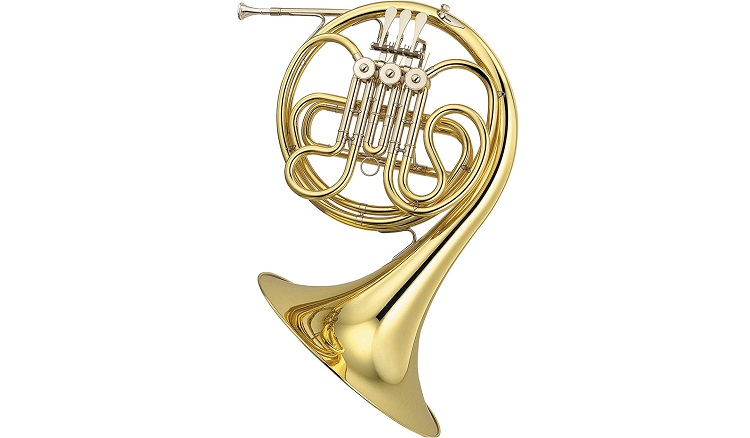
Yamaha makes excellent instruments, and the horns are no exception. If you want to buy a horn for a lower price, the YHR-314II is a good choice. The single horn is in the key of F, so you can use it to play a lot of basic horn music. It’s also relatively lightweight, so beginners and people who can’t hold a lot of weight will enjoy it.
On the horn, the valves taper and offer a warm and rich tone. The mouthpiece also tapers, and that can help you with tuning and intonation so that you can sound good alone and in a group.
Pros
- Lightweight
- Good design
- Resists corrosion
Cons
- You may outgrow it quickly
Holton H379
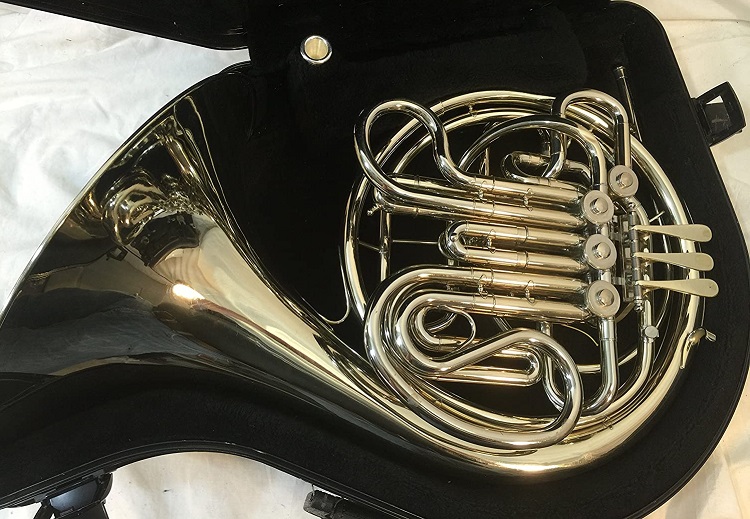
Another great horn to consider is the Holton H379, which is technically an intermediate model. It’s a double horn that can sound in the keys of F and B flat, so you can use it longer than a single horn. The instrument sounds dark and warm, and it can project well so that you’ll be heard. This model also responds relatively quickly, so you don’t have to anticipate the music as much, but you won’t sound late either.
Like the Yamaha horn, this one has slides that won’t corrode super easily, so the instrument can last longer. As a beginner, you can stick with the key of F side, and you can expand to the other side later.
Pros
- Great sound
- Flexible for beginners and intermediate players
- Not too expensive
Cons
- Can be a bit heavy
Conn 6D
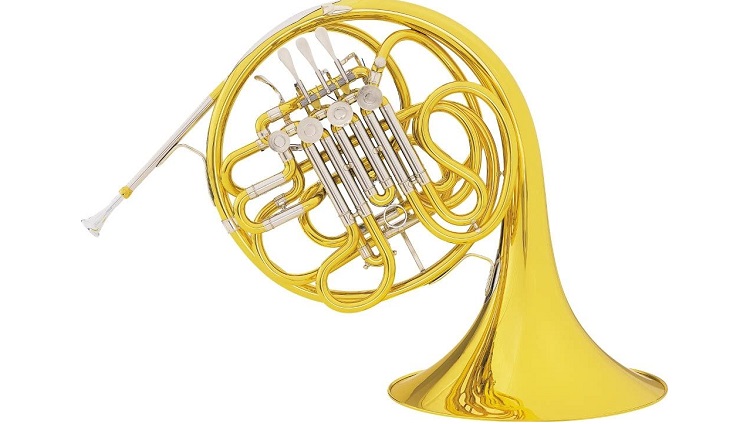
The Conn 6D horn is a great double horn for beginning and advancing horn players. It can be in the key of F or B flat, so you can access a bigger range of notes as you learn more. This horn has tapered rotars, a medium bell, and a yellow brass leadpipe. You’ll get a mouthpiece with it, so you can start playing the instrument as soon as you receive it.
Conn makes the instrument easy to control, but it offers professional features. It’s a fantastic option if you don’t want to have to upgrade to a different model later.
Pros
- Double horn
- Professional features
- Comes with what you need
Cons
- More expensive than some horns
Horn Accessories You Need
While brass instruments don’t need as many accessories as woodwind instruments, you need more than a horn. That way, you can keep your instrument in good shape, and you can make yourself more comfortable when you play.
Keep these accessories in your horn case for easy access. Whether you practice at home or another location, you’ll always have what you need to start playing. Here are some supplies and accessories to help you learn how to play the horn.
Mouthpiece
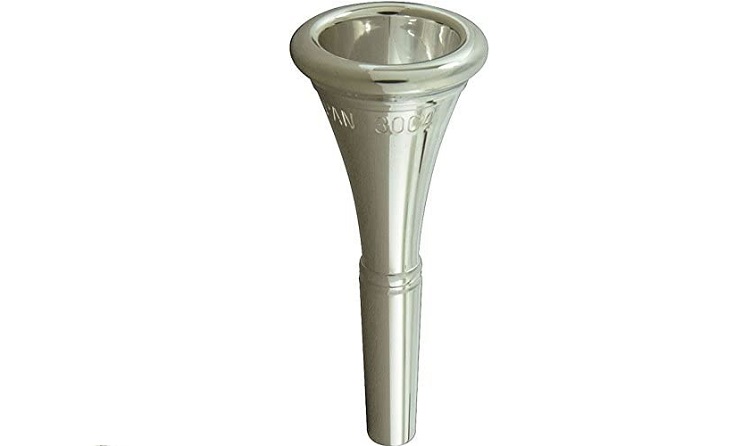
A good beginner horn will come with a mouthpiece you can use to start learning. However, many players will want to upgrade to a new mouthpiece at some point, even if they never get a different horn.
Your mouthpiece is where you make a sound, so you want something that you like and can use. For example, you may want a mouthpiece with a bigger sound to play in large orchestras, but you might want a different one for playing solo.
And if you happen to buy or rent a used horn, it may not have the mouthpiece. Consider what music you want to play to help decide on the best mouthpiece for you.
Hand Guard

Once you start to play the horn consistently, consider getting a hand guard to help avoid pain or discomfort. A handguard is a piece of fabric that you put on the tubing of the horn by the valves. It gives your left hand a more comfortable surface to rest on, so you don’t have to touch the metal directly. Using a hand guard is especially useful if the metal is cold.
But you can use a handguard at any temperature, and you don’t have to be a professional. If you already suffer from hand pain, it can be a good investment before you start to play the horn.
Cleaning Supplies
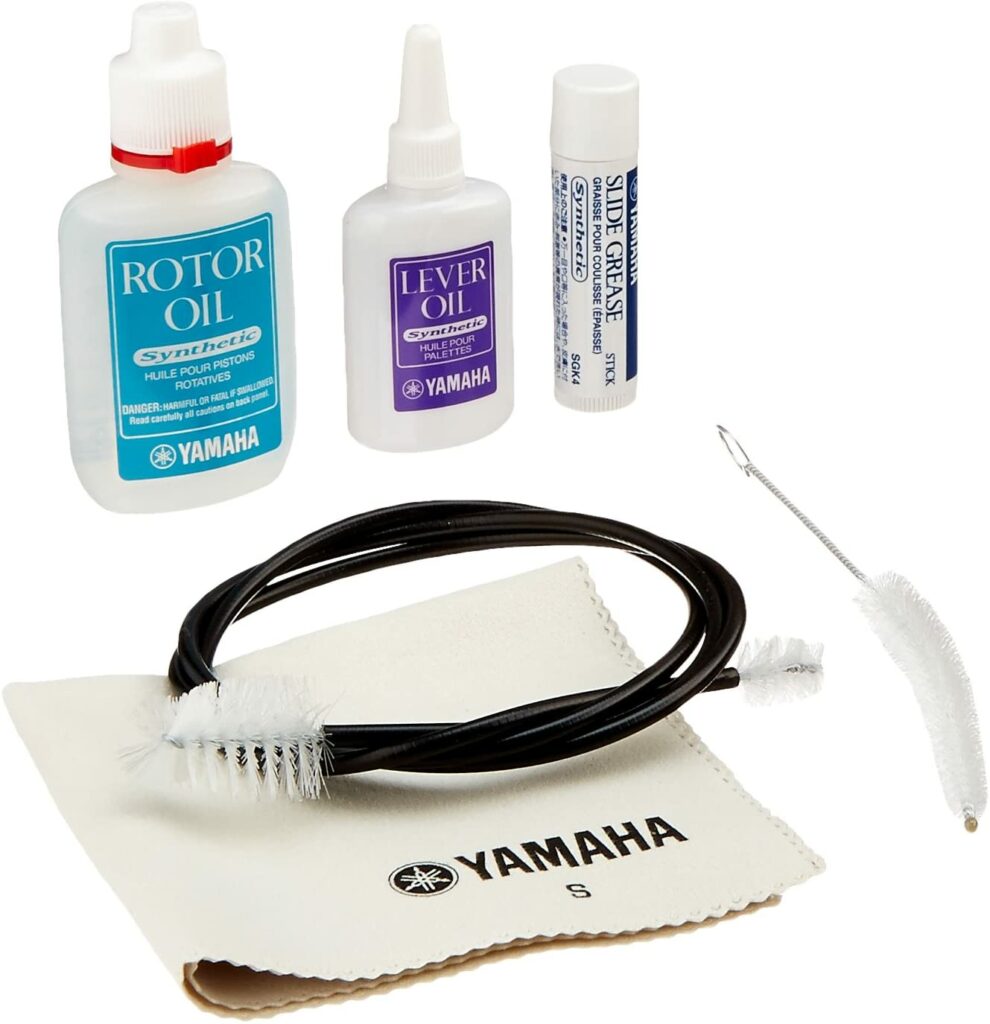
A cleaning kit is crucial for keeping your horn in good shape. If you don’t clean your horn regularly, condensation can build up and cause problems inside the instrument. You may also find that valves get harder to press if you don’t use valve oil to lubricate them. And you’ll need some way to collect the condensation when you drain the slides on the horn.
Fortunately, you can find a cleaning kit with everything you need so that you don’t have to buy items separately. Keep the kit in your case and use the supplies whenever you play to keep your horn from needing extra repairs.
How To Play The Horn
Now that you have a good quality instrument and some accessories, it’s time to learn how to play the horn. As you start to learn, be patient with yourself. Brass instruments are hard to play, and the horn can be especially difficult. But you can learn how to play it as long as you stick with it and practice regularly.
Here’s how you can learn the basics and play the horn.
Forming An Embouchure
If you’ve never played a brass instrument, you may need to spend a bit of time working on your embouchure. This is how you form your lips to create a sound, and brass instruments require a buzzing sound. To create a horn embouchure, put your lips together and close them. Take a deep breath through your nose and blow out through your mouth without opening your lips.
After a few tries, you should be able to get a buzz-like sound. Practice buzzing a few more times without the mouthpiece. Once you get comfortable with that, you can add the horn mouthpiece. You should place about one-third of the mouthpiece over your bottom lip, and the other two-thirds will go over your top lip. If that doesn’t work, experiment with the placement to find what works for you.
Practice forming an embouchure and buzzing with the mouthpiece. You can do this as a warmup as you learn, meaning you can always stay on top of that part of your playing.
Assembling And Holding The Horn
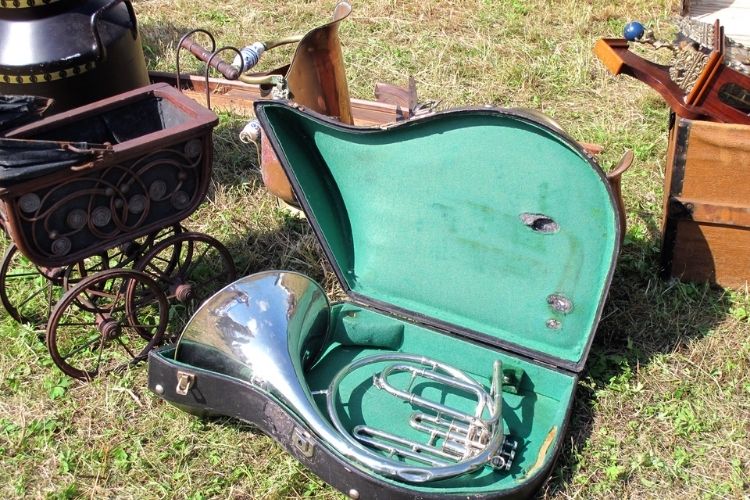
When you feel comfortable making a sound with the mouthpiece, you can add the rest of the horn. Fortunately, assembling the instrument isn’t too hard.
All you need to do is put the mouthpiece in the open end of the leadpipe, which is the thin end of the tubing. If you happen to have a horn with a screw-on bell, you will also need to put the bell on the instrument, but most beginners don’t have one like that.
As you get ready to play, you’ll need to put your horn in the correct position. You should hold your left hand over the valves on the horn using your first three fingers. If you have a double horn, you’ll place your thumb over the thumb valve.
Use your right hand to support the instrument by placing it inside the bell. You may need to use a tuner to determine how far your hand should go without making the notes go out of tune. When you start to learn the horn, consider sitting as you play. Your leg can be another form of support for the bell of your horn, so you can focus on other aspects of your playing.
Your First Notes
Now, you’re ready to play a few notes on the horn. Horn music uses treble clef, and it’s usually in the key of F, meaning the notes you hear sound a fifth lower than what you see on a page.
The first note on a horn in F is the note E, which is on the bottom line of the treble clef. You’ll play this without pressing any of the valves. However, you can press the second valve plus the thumb valve if you have a double horn.
Next, you can play the note D just below that by pressing the first valve on a single or double horn. The third note to learn is the C below that, and you’ll play it with all valves open. Because C and E use the same fingering, it can be hard to get the right pitches. Be sure to put a tuner in front of you until you figure out what you need to do to differentiate the notes.
Your First Song
Practice the notes C, D, and E a few times until you get the hang of playing each of them. Once you gain confidence with those notes, you can play your first song or two. Hot Cross Buns is an excellent first song for any instrument because you don’t need a ton of pitches. Here are the notes that make up the song.
E D C
E D C
C C C C
D D D D
E D C
Another great song to play with three notes is Mary Had a Little Lamb. These songs are very simple, but they’re a great way to learn the basics of how to play the horn, and they’re more interesting than the individual notes.
Get A Good Book
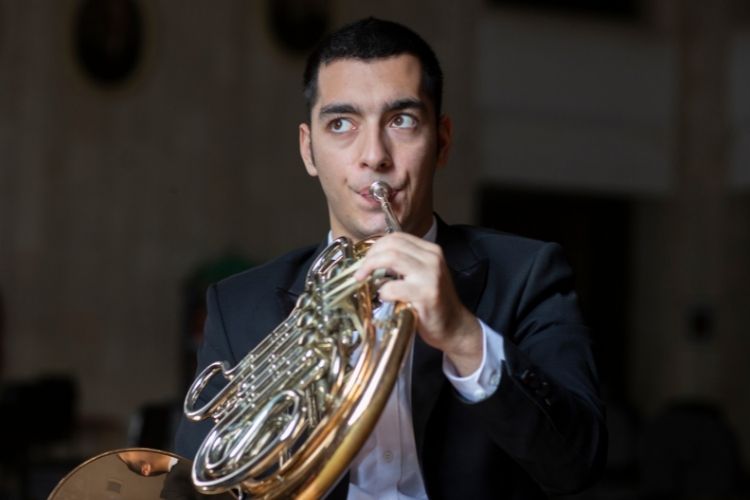
As you start to learn the horn, you should get a book with more songs and notes. You’ll be able to go through more lessons and materials, and you can make sure you learn how to play the horn well. The Rubank Elementary Method is affordable and great for many students. While it can be a bit boring, it lays out the fundamentals in a clear way to help you start learning.
If you’re learning the horn in a band or another group setting, you can also find a band method book for the horn. Those books contain songs that you can play with other instruments, and they also teach you the basics.
Whether you learn with or without a teacher, having a method book is critical. Without one, it can be hard to figure out what you should learn next. And once you finish the beginner book, you can move to the intermediate book in the same series.
Find A Private Teacher
Some instruments are easy enough to learn on your own, but the horn isn’t one of them. Even if you have a good method book, a teacher can guide you and provide personal feedback on your playing. Your teacher can also help you develop a practice plan to learn the horn. Whether you’re in school or have a busy work schedule, a practice plan is great for getting in a bit of practice each day.
That way, you’ll be able to make more consistent progress. And you don’t have to have a lesson every week if you can’t afford it or don’t have the time. Having a lesson once or twice a month will help you learn much more in less time than learning without a teacher. And your teacher can suggest supplemental resources to use between lessons.
FAQs
Answer: Compared to some instruments, you need to spend a lot of money on a beginner horn, and many factors go into the cost. The design requires a lot of precision and materials, which takes time and money to create.
And while you may be able to lower costs with cheaper metals, they won’t last long. Finally, some horn makers spend time and money researching how to improve the instrument, and that might affect the cost.
Answer: You may hear both terms interchangeably, and they can mean the same thing. However, the horn is actually from Germany, and there is a horn from France that isn’t as common.
Players can use either term, and many people will know the instrument you’re talking about. But you may also refer to the instrument as a horn in F, assuming that’s the key the instrument sounds in.
Answer: If you have a lot of motivation and discipline, you might be able to teach yourself how to play the horn. However, it can be very hard if you don’t have those factors to help you.
Whether you decide to get a private teacher or find another player to hold you accountable to practicing, you can learn the horn. Then, you don’t have to stress yourself financially to pursue the instrument.
Answer: The horn has a lot of tubing, even though it may not look that way. Because of that, you need to be able to move the air through all of that tubing to make a sound.
Another difficulty is the fact that the harmonic series (which is the basis of notes on the horn) is close together. That can make it hard to produce the right pitch, and different notes may require minute changes in your embouchure.
Answer: As a beginner, you can get away with playing a single horn for now. However, you may want to get a double horn as you learn more notes and music so that you can play even more.
If you want to avoid having to upgrade, you can find a good double horn for your first instrument. It will be more expensive, but it can be worth the investment if you know you’ll play the horn for a while.
Answer: Horn players can sit or stand to play, but sitting is usually better for beginners. When you sit, you can rest the bell on your right leg to add some extra support.
Standing to play requires a secure playing position, and it can be harder on your arms. You may need to hold the horn higher up to keep the instrument from falling.
Answer: Putting your hand in the horn bell can do a couple of things. First, it can help support the bell when you’re standing or sitting, so you don’t have to worry about dropping it.
You can also use your hand to change the pitch of individual notes without having to adjust the slides. Moving your hand in and out can change the pitch and the tone, which is sometimes useful.
Answer: The woodwind quintet is a common chamber group, and it includes flute, oboe, clarinet, bassoon, and horn. Horns are part of the group because they can blend well with woodwinds.
Players can blend even better with the woodwinds by placing their hand in the horn bell. Overall, the horn can be a great addition to a woodwind section for its tone, but it can also shine in a brass section.
Final Note On How To Play The Horn
Learning how to play the horn won’t happen overnight, so you should commit to the task. Not only do you need a good instrument, but you should find the time to practice consistently. Finding a teacher can help, but you may be able to learn a bit on your own. Either way, you should give yourself time to get used to making a sound and playing different notes to help improve your skills.
